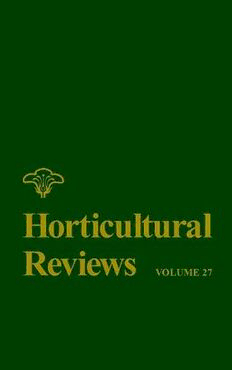
Horticultural Reviews, Volume 27 PDF
Preview Horticultural Reviews, Volume 27
HORTICULTURAL REVIEWS Volume 27 Horticultural Reviews: Volume 27 Edited by Jules Janick © 2001 John Wiley & Sons. ISBN: 978-0-471-38790-9 HorticulturalReviews is sponsoredby: American Societyfor Horticultural Science Editorial Board, Volullle 27 Nigel H. Banks Frederick T. Davies Susan Lurie HORTICULTURAL REVIEWS Volume 27 edited by Jules Janick Purdue University John Wiley 8' Sons, Inc. NEWYORK / CHICHESTER/ WEINHEIM / BRISBANE / SINGAPORE / TORONTO Thisbookisprintedonacid-freepaper.§ Copyright©2001byJohnWiley&Sons,Inc. Allrightsreserved. PublishedsimultaneouslyinCanada. Nopartofthispublicationmaybereproduced,storedinaretrievalsystemor transmittedinanyformorbyanymeans,electronic,mechanical,photocopying, recording,scanningorotherwise,exceptaspermittedunderSections107or108ofthe 1976UnitedStatesCopyrightAct,withouteitherthepriorwrittenpermissionofthe Publisher,orauthorizationthroughpaymentoftheappropriateper-copyfeetothe CopyrightClearanceCenter,222RosewoodDrive,Danvers,MA01923,(978) 750-8400, fax (978) 750-4744.RequeststothePublisherforpermissionshouldbeaddressedtothe PermissionsDepartment,JohnWiley& Sons,Inc.,605ThirdAvenue,NewYork,NY 10158-0012,(212)850-6011,fax (212)850-6008,E-Mail:[email protected]. Thispublicationisdesignedtoprovideaccurateandauthoritativeinformationinregard tothesubjectmattercovered.Itissoldwiththeunderstandingthatthepublisherisnot engagedinrenderingprofessionalservices.Ifprofessionaladviceorotherexpert assistanceisrequired,theservicesofacompetentprofessionalpersonshouldbesought. LibraryofCongressCatalogCardNumber: 79-642829 ISBN0-471-38790-8 ISSN0163-7851 1098 76 54 321 Contents Contributors ix Dedication: John V. Possingham xi Keith Boardman 1. The MolecularBiologyofFlowering 1 Steve van Nocker I. Introduction 1 II. Arabidopsis as aModelfor Flowering-Time Studies 2 III. Floral Inductive Pathways 3 IV. Role ofCarbohydrates 20 V. Control ofMeristemIdentity 21 VI. Competency 25 VII. ConclusionandPerspectives 28 LiteratureCited 30 2. FloralHomeotic Gene Regulation 41 Robert G. Franks andZhongchiLiu I. Introduction 42 II. Conservationofthe ABC FunctionsinAngiosperms 51 III. PositiveRegulators ofFloral OrganIdentityGenes 56 IV. NegativeRegulators ofFloralOrganIdentityGenes 63 V. Summary 69 LiteratureCited 71 v vi CONTENTS 3. Lingonberry: Botany andHorticulture 79 IngerHjalmarsson andRodomiro Ortiz 1. Introduction 80 II. History 81 III. Botany 87 IV. Management ofNatural Stands 93 V. Horticulture 99 VI. SummaryandFuture Prospects 111 LiteratureCited 114 4. CaperBush: Botany and Horticulture 125 GabrielO. Sozzi 1. Introduction 126 II. Botany 132 III. Ecophysiology 137 IV. Horticulture 140 V. PostharvestTechnology 156 VI. Compositionand Utilization 159 VII. InternationalTrade 170 VIII. ConcludingRemarks 172 LiteratureCited 173 5. WaterRelations and Irrigation Scheduling in Grapevine 189 M. H. Behboudian andZora Singh 1. Introduction 190 n. Phenology 191 III. Aspects ofWaterRelations 193 IV. Irrigation ofVineyards 207 V. QualityAttributes forWine, Dried, Table, andJuice Grapes 215 VI. FutureProspects 218 Literature Cited 219 6. Physiology and BiochemistryofSuperficial Scald ofApples and Pears 227 Morris Ingle I. Introduction 228 II. ScaldSymptoms andCell Changes 228 CONTENTS vii III. BiochemistryofScald 229 IV. PhysiologyofScald 245 V. AModel ofScaldDevelopment 253 VI. Prospects 259 LiteratureCited 262 7. Health FunctionalPhytochemicals ofFruit 269 Wilhelmina Kalt I. Introduction 270 II. Citrus 282 III. Grapes and Wine 291 IV. Vaccinium 298 V. OtherFruits 303 VI. Conclusions 307 LiteratureCited 308 8. Producing Sods overPlastic in Soilless Media 317 HenryF. Decker I. Introduction 318 II. Producing Sods in SoillessMedia 319 III. Developmentofthe Concept 321 IV. ProducingMature Sods overPlastic 327 V. Producing Sods for GolfGreens 330 VI. SolvingtheProblemofa Stable Continuum 331 VII. SubsequentProposals intheGenre 333 VIII. Manufacturing Sods 338 IX. NewMachinery 340 X. Future Potential 342 XI. Summary 345 LiteratureCited 346 Subject Index 353 Cumulative Subject Index 355 Cumulative ContributorIndex 377 Contributors M.H.Behboudian,InstituteofNaturalResources,CollegeofSciences, MasseyUniversity,PrivateBag11222,PalmerstonNorth, NewZealand KeithBoardman,6SomersCrescent,CanberraACT2603,Australia HenryF. Decker,BuckeyeBluegrassFarms,Inc., Box176,Ostrander, OH 43061 RobertG. Franks,DepartmentofCellBiologyandMolecularGenetics, UniversityofMaryland, CollegePark,MD 20742 IngerHjalmarsson,TheNordicGeneBank, Smedjeviigen3,POBox41, S-23053Alnarp,Sweden MorrisIngle,DivisionofPlantandSoilSciences, 1090AGSCIBD,POBox 6108,WestVirginiaUniversity,Morgantown,WV26506 WilhelminaKalt,AgricultureandAgri-FoodCanada,AtlanticFoodand HorticultureResearchCentre,Kentville, NovaScotiaB4NlJ5,Canada ZhongchiLiu,DepartmentofCellBiologyandMolecularGenetics, UniversityofMaryland, CollegePark,MD 20742 StevevanNocker,DepartmentofHorticulture,MichiganStateUniversity, 390PlantandSoilScienceBuilding,EastLansing,MI48824 RodomiroOrtiz,UTAc/oLambourn&Co., CarolynHouse, 26DingwallRoad, CroydonCR9 3EE,UK ZoraSingh,DepartmentofHorticulture,MureskInstitute ofAgriculture, CurtinUniversityofTechnology, GPOBoxU1987,Perth,WA6845, Australia GabrielO.Sozzi,DepartamentodeBiologiaAplicadayAlimentos,Facultad deAgronomia,UniversidaddeBuenosAires,Avda. SanMartin4453,C 1417DSEBuenosAires,Argentina ix v. John Possingham Dedication: John V. Possingham This volume is dedicated to Dr. John Possingham, an outstanding sci entistandadministrator, inrecognitionofhis outstandingcontribution to Australian horticulture and for his international efforts in horticul tural scienceand viticulture. Johnwas bornin1929andgrewup ona smallhorticulturalproperty inruralSouthAustralia. Hestudiedagricultureandplantphysiologyat the Universities ofAdelaide inAustraliaand at Oxford inEngland. He initiallyworkedinthefield ofplantnutritionattheLaboratories ofthe CommonwealthScientificandIndustrialResearchOrganisation(CSIRO) in Canberra establishing that manganese was essential for the photo chemical reactions of higher plant chloroplasts. In 1962 he accepted responsibilityfor CSIRO's program ofresearch inhorticulturethatwas mainlyconcernedwithgrapevinesandcenteredatMerbeinVictoria.He subsequently established horticultural laboratories at Adelaide, Dar win, and Brisbane that, together with an existing postharvest horticul turegroup atSydney,enabledCSIRO'sDivisionofHorticulturetocarry out awide-rangingprogram ofbasicandappliedhorticulturalresearch concentratingmainly onwine andraisingrape vines and ona range of selectedtropical and subtropical fruit crops. AtMerbein, Dr. Possinghamestablished a majorgrapevine improve ment program that covered virus-tested introductions from overseas andthebreedingofnewcultivarssuitedtothewarmirrigatedconditions of inland Australia. This program also included the development of grapevine rootstocks that were tolerant of Australian plant parasitic nematodes. New cultivars released from the "grape breeding program andadoptedbytheviticulturalindustriesinclude'Tarrango'forlightred wine; 'Carina',ablackseedlessraisin;andthetablegrape'MarrooSeed less'.Anumberofotherpotentialcultivarsarebeingevaluatedbyindus try. Dr. Possingham also obtained major government funding and establishedavineyardmechanizationprogrambasedonimportingpro totype grape harvesting machines from the University of California, Davis and Cornell University. Vine training and management systems were developed for use in mechanically harvested vineyards. These includedminimal pruning, which is now used extensivelyinwarmto hotgrape growingregions inbothAustraliaand California. xi
